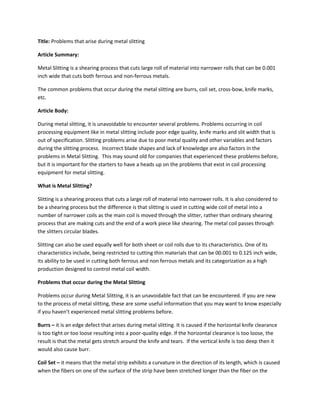
Problems that arise during metal slitting
- 1. Title: Problems that arise during metal slitting Article Summary: Metal Slitting is a shearing process that cuts large roll of material into narrower rolls that can be 0.001 inch wide that cuts both ferrous and non-ferrous metals. The common problems that occur during the metal slitting are burrs, coil set, cross-bow, knife marks, etc. Article Body: During metal slitting, it is unavoidable to encounter several problems. Problems occurring in coil processing equipment like in metal slitting include poor edge quality, knife marks and slit width that is out of specification. Slitting problems arise due to poor metal quality and other variables and factors during the slitting process. Incorrect blade shapes and lack of knowledge are also factors in the problems in Metal Slitting. This may sound old for companies that experienced these problems before, but it is important for the starters to have a heads up on the problems that exist in coil processing equipment for metal slitting. What is Metal Slitting? Slitting is a shearing process that cuts a large roll of material into narrower rolls. It is also considered to be a shearing process but the difference is that slitting is used in cutting wide coil of metal into a number of narrower coils as the main coil is moved through the slitter, rather than ordinary shearing process that are making cuts and the end of a work piece like shearing. The metal coil passes through the slitters circular blades. Slitting can also be used equally well for both sheet or coil rolls due to its characteristics. One of its characteristics include, being restricted to cutting thin materials that can be 00.001 to 0.125 inch wide, its ability to be used in cutting both ferrous and non ferrous metals and its categorization as a high production designed to control metal coil width. Problems that occur during the Metal Slitting Problems occur during Metal Slitting, it is an unavoidable fact that can be encountered. If you are new to the process of metal slitting, these are some useful information that you may want to know especially if you haven’t experienced metal slitting problems before. Burrs – it is an edge defect that arises during metal slitting. It is caused if the horizontal knife clearance is too tight or too loose resulting into a poor-quality edge. If the horizontal clearance is too loose, the result is that the metal gets stretch around the knife and tears. If the vertical knife is too deep then it would also cause burr. Coil Set – it means that the metal strip exhibits a curvature in the direction of its length, which is caused when the fibers on one of the surface of the strip have been stretched longer than the fiber on the
- 2. opposite surface. The strip curves towards the side having shorter fibers and the difference in fiber length are caused by winding the coil into a tight radius. Cross Bow - is a result from trying to correct coil set. The strips display curvature across its width properties. It may be caused by a major defect in the master coil from too much overlap in vertical clearance. It also occurs when the stripper rings used are the wrong size particularly when the male rings are too big or the female rings are too small. Camber – can be the result from the stresses in the master coil. It is also caused by if there are material defect in slitting the master coil upside down. Knife Marks – are caused by poor stripper ring practices that give the strip knife marks. Knife marks contributes to poor edge condition such as burrs and edge waves. This is also caused by incorrect ring size, match or durometer value causes the slitting knives to push material off incorrectly. Edge Wave – it is caused by the stresses in the metal. Too much vertical clearance, overlap may cause edge waves. Poor stripper ring practice is also a contributing factor. If the stripper ring OD is too small, the chances are to lover the knives to overcome slippage. It is better to be equipped with information that can help you pick the right material and right people to help you and advice useful information that would help you eliminate metal slitting problems. If you don’t understand good stripper ring practices the tendency is that you would be encountering troubles in setting up the machine with precision. It is recommended to consult coil processing experts with regards to correcting and setting up coil processing equipment and proper application.
